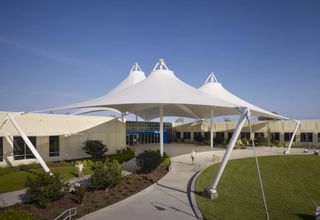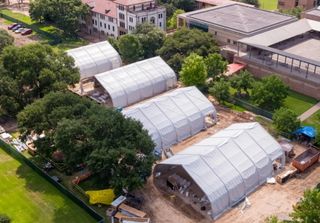Since COVID-19 is believed less likely to spread in outdoor settings, many higher ed institutions will offer classes under tents this fall. The move may be reminiscent of the outdoor schools that existed in the U.S. during the early 20th-century era of tuberculosis, but today’s administrators and teachers are finding creative ways to bring the technology of a modern classroom out onto the quad.
Outside but Online

As soon as the campus at Eckerd College in St. Petersburg, Florida, shut down in March, Beth Forys knew she wanted to teach in the open air during the fall. “I had actually taught outside quite a bit as did many faculty. We have an 188-acre campus,” says Forys, a professor of environmental science and biology. She worked with Noelle Boucquey, an assistant professor who teaches environmental studies, to help the university set up outdoor class spaces.
In addition to tented areas, Boucquey and Forys identified areas on campus with overhangs and tree-shaded areas. “I teach GIS computer mapping,” Forys says. Using the program ArcGis she was able to model how many students might fit under a given area while maintaining the necessary social distancing. Some of the covered outdoor spaces will be reserved for specific classes, others will be used on a first-come, first-serve basis.
Even while teaching outdoors, professors will utilize technology. Each spot identified has strong WiFI signals, and instructors will have access to Logitech C930E business webcam as well as a ZOWEETEK portable voice amplifier and headset. Both devices will be powered by the laptops educators are issued and allow them to connect with students who have opted to take classes remotely. PowerPoint presentations can also be broadcast to students’ laptops and phones over WiFi.
While this push outdoors was prompted by health considerations, it could lead to more outdoor classes even after the pandemic is over. “I frequently take my classes outdoors anyway just for discussing books and articles that we’ve read,” Boucquey says. “I find that outside, people sometimes feel more comfortable speaking up. I think it’s just something about the setting that relaxes people a little bit and they can actually contribute more.”
Under the Big Top

The first discussions around tents and outdoor classes at Rice University in Houston, Texas, were not focused on slowing the spread of COVID-19.
“The idea didn’t come from a health perspective initially,” says Kevin Kirby, Rice University’s vice president for administration. “Really it came up from a bit of a statement perspective. These are challenging times for everybody and someone suggested, ‘Why don't we put up circus tents as a statement of resolve and creativity.’”
Because these proposed tents would also encourage people to get outside and provide more opportunities to space out students, the administration decided to go forward with the proposal and purchased 11 tents. Some are semi-permanent, fully enclosed spaces with AV equipment and even air conditioning. Others are open-sided tents, and there are also two canvas-covered areas. The enclosed tents will function the same as indoor spaces with regularly scheduled classes.
While the semi-permanent tents don’t necessarily have the same health advantages as a sideless outdoor tent, they allow the university to schedule more classes that meet distancing capacity requirements. The other tents and covered spaces will not hold scheduled classes, but Kirby says they hope they will be used by professors who bring their classes outside for impromptu sessions and for staff and student meetings. “We're trying to get people to use the outdoors more,” he says.
To that end, the university has also purchased 1,500 lightweight camping chairs to distribute to the student body. In keeping with the spirit of the original tented concept, Kirby says he and other administrators considered purchasing striped circus-style tents. Instead, they decided on purchasing white tents and letting their art students and faculty members use them as canvases. Plans are underway for murals to be painted on the tents, as well as video installations to be projected. “They're very excited,” Kirby says of the arts community.
Winter is Coming
Even at universities in cold-weather regions, tents and outdoor classes are being pursued. Some University of Pittsburgh students will take classes under tents. Amherst College, in Amherst, Massachusetts, ordered tents over the summer and set an earlier start date for the semester.
Colleges that have not yet set up tents may still have time to identify suitable outdoor class spaces on campus, Boucquey says. “Canvass your whole campus,” she urges. “We kept finding areas we hadn’t really thought of. It’s really important to get outside and do the gumshoe work.”


